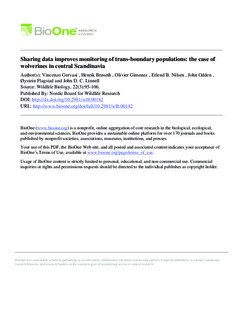Sharing data improves monitoring of trans-boundary populations: the case of wolverines in central Scandinavia
Gervasi, Vincenzo; Brøseth, Henrik; Gimenez, Olivier; Nilsen, Erlend Birkeland; Odden, John; Flagstad, Øystein; Linnell, John Durrus
Journal article, Peer reviewed
Published version

Åpne
Permanent lenke
http://hdl.handle.net/11250/2475632Utgivelsesdato
2016Metadata
Vis full innførselSamlinger
- Publikasjoner fra CRIStin - NINA [2364]
- Scientific publications [1392]
Sammendrag
of wide-ranging species are likely to extend across multiple jurisdictions, including national and international borders. This requires that local institutions implement data sharing and a standardization of monitoring designs. However, a formal evaluation of the benefits of integrated monitoring systems had not, of yet, been performed. Using the wolverines in central Scandinavia as a study case, we assessed the benefits of data sharing for the monitoring of trans-boundary populations. We also assessed the performance of two demographic monitoring systems, one relying on a count of reproductive units, the other resulting from non-invasive genetic sampling and capture-recapture modeling. Sharing data across the border between Norway and Sweden allowed a strong increase in the precision of population size, population growth rate and vital rates estimates. It also allowed revealing that the probability to emigrate from Sweden to Norway was significantly higher than in the opposite direction, a required condition for the existence of a source–sink dynamics. These findings would have been impossible without trans-boundary data sharing. While the den count monitoring provided an estimated population growth of 138% over the 12-year period, the DNA-based estimate was only 72%. A positive trend likely occurred in the detectability of wolverine dens during the first years of the study, and the index was not able to separate the actual demographic trend from the trend in the system’s ability to detect reproductions, thus providing positively biased estimates of population growth rate during the initial phase of the study. Data sharing is a crucial need for the study of the processes occurring in trans-boundary populations. It should be enhanced wherever trans-boundary ecological processes occur. Also, managers should be aware that count-based monitoring has a risk of overestimating population growth during the first years after its implementation.
